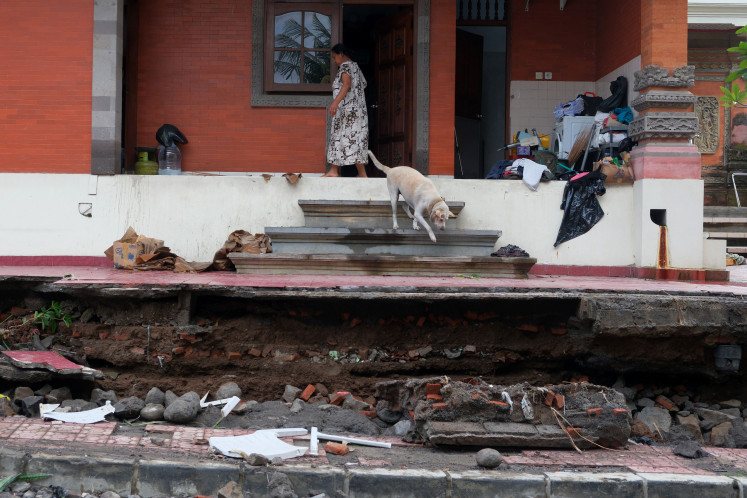Popular Reads
Top Results
Can't find what you're looking for?
View all search resultsPopular Reads
Top Results
Can't find what you're looking for?
View all search resultsASEAN economies past and future
Many experts have forecast promising economic growth from member states of the Association of Southeast Asian Nations (ASEAN)
Change text size
Gift Premium Articles
to Anyone
M
any experts have forecast promising economic growth from member states of the Association of Southeast Asian Nations (ASEAN). And there are several reasons for such expectations, including the region’s advantageous location, global security, the global economy and its policies over the last two decades.
But history has also shown us evidence of the presence of great nations in the ASEAN region in the past. The golden age of Sriwijaya, Majapahit and many other kingdoms in Southeast Asia are in the remaking now, albeit under a different banner: ASEAN countries.
The most important reason for this is the location advantage of the region, which connects two economic giants, China and India, as well as the Middle East and Western nations.
The second most important factor is global security in the past and in the future. The formation of Singapore by Thomas Raffles and the “cooperation” between the British and Dutch in the early 19th century after the Napoleonic Wars in Europe provided security for an economic connection between some Southeast Asian countries and the rest of the world.
The rise of Singapore as the center of trade in Southeast Asia has also provided a better linkage among Southeast Asian nations. However, during the two world wars and the Cold War era, Southeast Asia was one of the centers of battles between great powers. Today, threats of terrorism have also affected this region, especially Indonesia.
The third most important factor is the global economy and its policies. In the past, before Arabs and Western influenced Indonesia, or when India and China became the poles of the global economy, the region was known as “the busy road”, which allowed nations on both sides of the Malacca Strait and Java to enjoy a golden age of trade growth.
If both India and China reemerge as great economic powers, the golden age of this region will reemerge. The simplest explanation of this could be taken from the gravity model: The increasing economic size of both India and China and “the attraction of the economic force” of these giants will impact positively on the economy of this and the ASEAN region.
Economic policy is another important factor in the future of this region. There are at least three institutions helping this region remain on the right track in international trade relations — ASEAN, APEC (Asia Pacific Economic Cooperation) and the WTO (World Trade Organization). Despite many criticisms, especially during the Asian financial crisis of the late 1990s and during the global financial crisis of 2008, these institutions have helped the world, particularly ASEAN, face the challenges.
ASEAN has ratified the AFTA (ASEAN Free Trade Agreement) and the ASEAN-China Free Trade Area (ACFTA). There also other forms of communication forums between ASEAN and other economies, especially with the European Union (EU).
The following facts will help us understand the big picture of economic relations between ASEAN and some major economies, particularly APEC member countries.
The dynamic economic relations between ASEAN founding members (ASEAN-5) and economic powers within APEC were manifested in their trade volume in 1999-2009. Trade between ASEAN-5 and China rose from 3.7 percent from the grouping’s total trade volume in 1999 to 11.1 percent in 2009; ASEAN-5 and Japan trade dropped from 15.9 percent in 1999 to 10.36 percent in 2009; ASEAN-5 and the US’ trade declined from 18.7 percent in 1999 to 9.66 percent in 2009; and trade between ASEAN-5 and APEC economies slumped from 75.1 percent to 72.8 percent in 2009.
The region’s advantageous location, global security, global economy and its policies during the period explain the trade relations well.
First, the ASEAN-5 countries are located in a strategic and advantageous region. Among the ASEAN-5, Singapore booked the fastest average economic growth during 1989-2009 with 6.73 percent, with Malaysia 6.15 percent, Indonesia 5.16 percent, Thailand 5.02 percent and the Philippines 3.79 percent. The location of Singapore and Malaysia near the Malacca Strait (and supported by their seaport infrastructure) are better than the other three economies. However, overall, this region has a very good location in connection with international trade.
Second, during the last two decades (1989-2009), there were no important global conflicts that affected this region. The war on terrorism has hardly impacted the region’s security either.
Third, during this period, the world economy grew by a positive 2.69 percent. APEC economies growth during the same period was 2.83 percent. In comparison economic growth of main APEC economic powers like Japan was 1.31 percent, the US 2.52 percent and China 9.98 percent.
Economic growth in simple average of ASEAN-5 (Indonesia, Malaysia, Philippines, Singapore, and Thailand) during the last two decades stood at 5.37 percent. This shows that ASEAN-5 and China’s economies are becoming more important in the world economy in APEC and the world.
ASEAN countries have a better choice in keeping their relations closer to each other. This strategy will give a better “power” because unilateral action will weaken individual nations in the face of great powers. As small open economies, ASEAN countries should be very responsive to the global events that build relations with the great economic and political powers.
ASEAN’s advantageous location is a blessing, but it will turn into a curse if members of the group act individually and only serve the interests of great powers as happened in the past.
The writer is a researcher at the University of Indonesia’s School of Economics and director of the university’s APEC Study Center (ASC UI)










